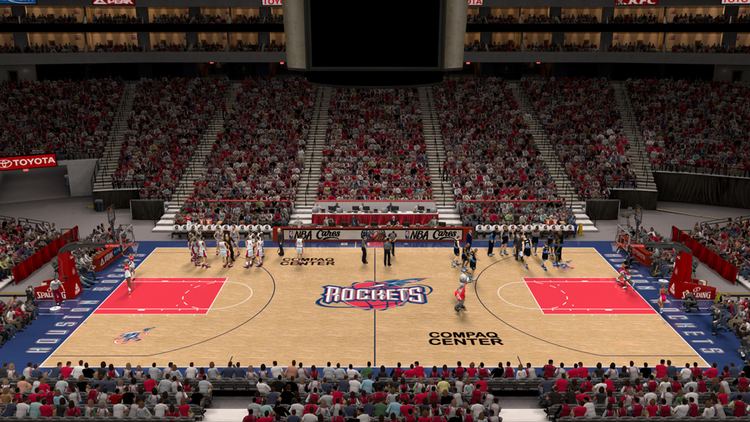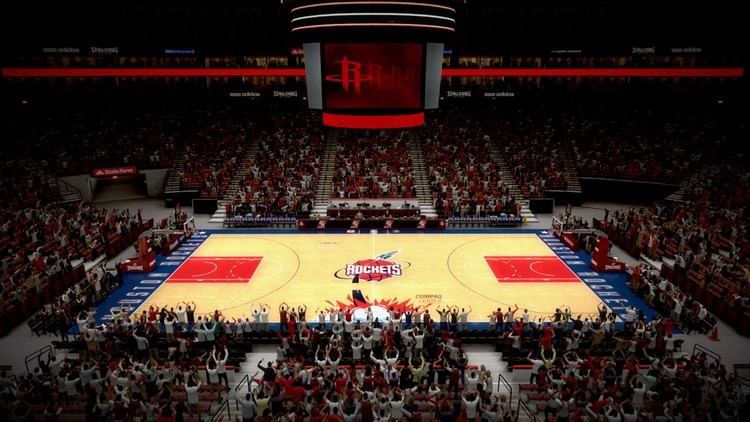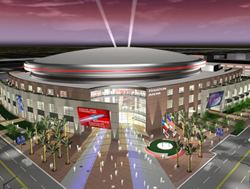Broke ground December 1973 Capacity 16,285 | Surface Wood Reopened July 16, 2005 Opened 7 November 1975 | |
 | ||
Similar Lakewood Church, Reunion Arena, McNichols Sports Arena, Sam Houston Coliseum, Charlotte Coliseum | ||
The Lakewood Church Central Campus (originally The Summit and formerly Compaq Center) is a house of worship in Houston, Texas. It is located about five miles southwest of Downtown Houston, next to the Greenway Plaza.
Contents
From 1975 to 2003 the building served as a multi-purpose sports arena, for various professional teams in Houston, most notably the NBA's Houston Rockets.

From its opening until 1998, the building was known as The Summit. Computer technology firm Compaq bought naming rights to the building after that and it was known as Compaq Center until 2003. At that point the name was dropped, coinciding with opening of the Toyota Center as a new professional sports venue in Houston. Shortly after, the building was leased out to Lakewood Church for use as its main facility. Lakewood Church purchased the building outright in 2010.

Construction of The Summit

In 1971, the National Basketball Association's San Diego Rockets were purchased by new ownership group Texas Sports Investments, who moved the franchise to Houston. The city, however, lacked an indoor arena suitable to host a major sports franchise. The largest arena in the city at the time was 34-year-old Sam Houston Coliseum, but the Rockets would not even consider using it as a temporary facility. Plans were immediately undertaken to construct the new venue that would become The Summit. The Rockets played their home games in various local facilities such as Hofheinz Pavilion and the Astrodome during the interim.
Completed in 1975 at a cost of $18 million, The Summit represented a lavish new breed of sports arena, replete with amenities, that would help the NBA grow from a second-tier professional sport into the multibillion-dollar entertainment industry that it is today. The Omni in Atlanta (now the site of Philips Arena), McNichols Sports Arena in Denver (now a parking lot for Sports Authority Field), and the Coliseum at Richfield in Cleveland (now an open meadow in the process of being reclaimed by forest) were all constructed during this period and remained in service until the continued growth of the NBA sparked a new arena construction boom in the late 1990s.
On each end of the arena was a Fair-Play scoreboard with a small two-line monochrome message center. Both scoreboards would be upgraded in 1986 with the addition of three front-projection videoboards on top of each scoreboard. The center videoboard showed live game footage, fan shots, and replays while the left and right videoboards showed slides displaying advertisements for the Rockets' (and Aeros') sponsors.
Sports
It housed the Rockets, Aeros, Comets and several arena football sports teams until they vacated the arena in favor of the new Toyota Center in downtown Houston. Additionally, the arena was a prime Houston venue for popular music concerts and special events such as Ringling Bros. and Barnum & Bailey Circus, the Harlem Globetrotters, Sesame Street Live and Disney on Ice.
It hosted the NBA Finals on four different occasions: 1981, 1986, 1994 and 1995. In 1994 and 1995, the then-Summit was the site of the deciding games in the championship series and of the ensuing celebrations. The Summit was also host to championship teams from 1997 to 2000 when the Houston Comets won the WNBA title for four consecutive years.
The first professional wrestling event at the Summit was promoted by the American Wrestling Association on May 29, 1977, headlined by champion Nick Bockwinkel drawing Terry Funk. On January 7, 1979, Dusty Rhodes won the NWA Texas Brass Knuckles Championship from Mark Lewin. The World Wrestling Federation aired the first TV card from the venue on October 19, 1986, featuring Hulk Hogan defending his title against Paul Orndorff and a $50,000 tag team battle royal. It held the Royal Rumble on January 15, 1989. This was the first time the Royal Rumble, won by Big John Studd, was televised on pay-per-view (PPV). The newly renamed Compaq Center hosted the No Way Out of Texas PPV on February 15, 1998, and Bad Blood (the first brand-exclusive PPV held in the United States) on June 15, 2003. It hosted a live episode of SmackDown! on September 13, 2001, the first major entertainment event in the US after the September 11 attacks.
Notable concerts
Prior to the construction of Toyota Center, the Summit was the principal Houston venue for large pop and rock music concerts.
The first major rock concert at The Summit was when The Who began the US leg of their North American tour on November 20, 1975, supported by Toots and the Maytals. The concert was recorded and later released in 2012, as The Who: Live in Texas '75. It is also featured on the "30 Years of Maximum R&B" DVD set.
On October 31, 1976, Parliament-Funkadelic performed at the Summit during the P-Funk Earth Tour. The performance was recorded and released, as The Mothership Connection – Live from Houston in 1986 and later rereleased on DVD, as George Clinton: The Mothership Connection in 1998. A DVD of one of the opening acts, Bootsy's Rubber Band, was also released by P-Vine records.
In September 1977 the band KISS played two sold-out shows. The presentations were recorded and are part of the first volume Kissology.
Bruce Springsteen & The E Street Band's December 8, 1978 show was released on DVD in 2010, as part of The Promise: The Darkness on the Edge of Town Story box set.
The Bee Gees played a sold-out concert at The Summit on June 30, 1979 as part of their Spirits Having Flown Tour.
On October 7, 1981, Australia's Little River Band performed at the venue in support of its Time Exposure LP. The concert was filmed and released on videotape (and eventually DVD) as Live Exposure.
Journey performed during their Escape Tour on November 5–6, 1981, the show on the 6th was recorded and shown on MTV and later released as a CD/DVD package, entitled Live in Houston 1981: The Escape Tour, in November 2005.
Pop Superstar Michael Jackson performed 3 concerts at The Summit during his Bad World Tour on April 8, 9 and 10 1988
ZZ Top's final stop on their Beer Drinkers and Hell Raisers Tour, on November 22, 2003, was the last ever concert performed live at the arena, before it was renovated into a church.
From vacancy to Lakewood Church
In 1998, it became the first Houston sports arena to sell its naming rights. The Arena Operating Company entered into a five-year, $900,000 per year deal with then Houston-based Compaq Computer Corporation to change the name of the venue from The Summit to Compaq Center, keeping that name even after the acquisition of Compaq by Hewlett-Packard in 2002 (there was another arena named the Compaq Center in San Jose, California around this time, but has since been renamed the SAP Center). The length of the agreement was significant, because in 2003 the lease that Arena Operating Company held on Compaq Center would expire, and the tenants of the building were lobbying vigorously for the construction of a new downtown venue to replace the aging and undersized arena.
When the sports teams moved to the new Toyota Center in 2003, the City of Houston leased the arena to Lakewood Church, a megachurch, which invested $95 million in renovations to convert the arena into the current configuration of seats and rooms for its needs; the renovations took over 15 months to complete, and the renovations included adding five stories to add more Capacity. During the lease, Lakewood Church had an exclusive agreement with the City of Houston for use of the former Summit, and as such, invested heavily in the structure for its use. In 2001, the church signed a 30-year lease with the city.
In March 2010, the church announced that it would buy the campus outright from the city of Houston for $7.5 million, terminating the lease after 7 years. Marty Aaron, a real estate appraiser, said that while an "untrained eye" would "wonder how Lakewood Church purchased the Compaq Center for $7.5 million, when this is not really an arms-length sale from the city to Lakewood Church." Aaron explained that the church "put a phenomenal amount of money into the facility after the lease was initially structured, and it's really not fair that someone else would get the benefit of that." Aaron added that converting the property to a stadium-oriented facility "would probably cost as much or more than it took to turn it into a church, and right now there are probably not very many organizations that would be willing to step forward and do that." The Houston City Council was scheduled to vote on the matter on Wednesday March 24, 2010. City council delayed the vote. On March 30 of that year, Ronald Green, the city's chief financial officer, said that he approved of the sale of the building. On March 31, 2010 the Houston City Council voted 13–2 to sell the property to Lakewood.
